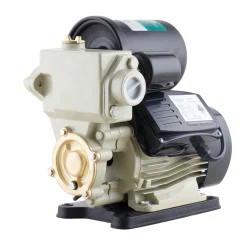Uses of peripheral booster pumps
2024-01-02
Peripheral booster pumps are a type of water pump commonly used to increase water pressure in residential and commercial applications. These pumps are a subset of centrifugal pumps and are designed to enhance water flow in systems where the existing pressure is insufficient. Here are some key features and uses of peripheral booster pumps:
1. Centrifugal Pump Design:
- Peripheral booster pumps are a type of centrifugal pump, which means they use a rotating impeller to move water. The impeller spins at high speeds, creating a centrifugal force that propels water outward.
2. Peripheral Impeller Design:
- The distinctive feature of peripheral pumps is their impeller design. Unlike typical centrifugal pumps with a radial vane impeller, peripheral pumps have a peripheral or turbine-like impeller. This design allows for higher speed and efficiency in generating pressure.
3. Boosting Water Pressure:
- The primary purpose of these pumps is to boost water pressure in systems where the natural pressure is insufficient. They are commonly used in buildings or areas where the municipal water supply pressure is inadequate.
4. Applications:
- Peripheral booster pumps find applications in various settings, including residential homes, apartments, irrigation systems, and small commercial buildings. They are often employed when there is a need for increased water pressure for showers, faucets, and other water outlets.
5. Compact and Lightweight:
- Peripheral booster pumps are typically compact and lightweight, making them easy to install and suitable for applications with space constraints.
6. Low to Moderate Flow Rates:
- These pumps are generally suitable for low to moderate flow rate requirements. They work well in scenarios where the demand for water is not exceptionally high.
7. Easy to Install:
- Peripheral booster pumps are known for their simplicity in installation. They are often mounted directly onto the plumbing system and are relatively easy to integrate into existing water supply setups.
8. Maintenance:
- Maintenance requirements for peripheral booster pumps are usually straightforward. Regular checks on the impeller, motor, and seals, as well as occasional cleaning, are common maintenance tasks.
When selecting a peripheral booster pump, it's important to consider factors such as the required pressure boost, flow rate, power consumption, and the specific application. Additionally, following the manufacturer's recommendations for installation, operation, and maintenance is essential to ensure optimal performance and longevity of the pump.



